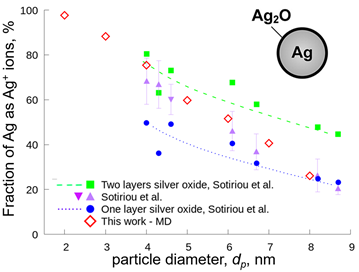Nanosilver is a nanomaterial commodity used commonly into consumer products, such as food containers, bandages, and cosmetics. In addition, silver nanoparticles show high antibacterial activity finding applications in biomedical products. However, there are concerns about the adverse effects of nanosilver on human health due to release of silver ions from the nanoparticle surface, as leaching is associated with nanosilver toxicity. Prior experimental studies (Sotiriou et al., 2012) indicated that the release of silver ions originates from one or two oxidized monolayers formed at the nanoparticle surface.
Here, the oxidation of silver nanoparticles made by flame spray pyrolysis is investigated at high temperature by reactive molecular dynamics. The oxidation rate equation is obtained ab initio as a function of temperature and particle coverage. Figure 1 shows the fraction of silver ions in nanosilver particles as function of particle size obtained by reactive molecular dynamics simulations (diamonds). The results are in excellent agreement with experiments of flame- and wet-made nanosilver (triangles) in aqueous suspensions. For comparison, the estimated silver ion fractions assuming one (circles) and two (squares) silver oxide layers are shown. Nanosilver particles with diameter of 3 â 4 nm exhibit a large fraction of silver ions, which are present in the form of silver oxide at the particle surface. This fraction corresponds to a double layer of silver oxide. Larger silver nanoparticles, having diameter of 7 â 8 nm, exhibit a smaller fraction of silver ions that corresponds to a single silver oxide layer, consistent with experiments (Sotiriou et al., 2012). In addition, the effect of particle size on the leaching rate of nanosilver in aqueous solutions is quantified to understand the mechanism of silver ion release, which is responsible for the nanosilver toxic manifestations. Minimising these release rates can enable the expanded use of silver nanoparticles and their nanocomposites as bioimaging materials or plasmonic biosensors.
References
Sotiriou, G. A., Meyer, A., Knijnenburg, J. T., Panke, S., & Pratsinis, S. E. (2012). Quantifying the origin of released Ag+ ions from nanosilver. Langmuir, 28(45), 15929-15936.


